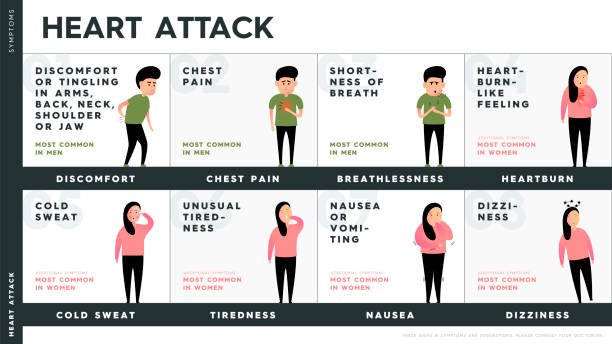
Graphical Explanation of the Difference Between Myocardial Infarction and Angina Pectoris! Understand the Symptoms, Types and Treatments At Once
Angina pectoris and myocardial infarction are both common coronary heart diseases. When atherosclerosis occurs in the coronary arteries, the arteries lose their elasticity, the walls become thicker, and the inner chamber gradually becomes narrowed or blocked, making it difficult for blood to circulate, which may cause angina pectoris, myocardial infarction.
Cardiovascular disease has jumped to No. 1 among the top 10 causes of death in the world. The most common cardiovascular disease is myocardial infarction. However, both myocardial infarction and angina pectoris cause chest pain. What is the difference between the two? What are the symptoms? Let this article tell you!
What is the difference between angina pectoris and myocardial infarction?
Angina pectoris and myocardial infarction (MI) both cause chest pain and other symptoms, but they are actually different.
Angina pectoris can be said to be a general term for symptoms that can cause chest tightness and chest pain. Most of the chest pain is tolerable, lasts about 15 minutes, and can be relieved by rest. Symptoms may include nausea, indigestion and difficulty breathing.
Myocardial infarction is a serious disease. When the coronary arteries are completely blocked, myocardial necrosis occurs, resulting in myocardial infarction. The chest pain is usually unbearable and can last for more than 30 minutes. It cannot be relieved even after rest. . Symptoms may include dizziness, vomiting, weakness in limbs, difficulty breathing, and fainting.


What is angina?
Angina pectoris, also known as angina, is mainly caused by reduced blood flow due to blockage of the coronary arteries, which cannot provide enough oxygen to the myocardium, resulting in an imbalance between the supply and demand of myocardial oxygen. Once the amount of exercise increases, coronary blood flow cannot provide the myocardial oxygen consumption demand, and transient myocardial hypoxia will occur. When the coronary artery lumen is narrowed by more than 75% and the myocardial blood flow is insufficient at rest, angina pectoris symptoms will occur.
Angina pectoris symptoms
- Chest tightness, chest pain
- Pain in the jaw, back, arms, neck, and abdomen
- Nausea, vomiting and indigestion
- The attack time may range from a few minutes to 15 minutes. During the attack, there will be a feeling like being pressed by a heavy object and difficulty breathing in the center of the chest, but most of them can still be tolerated. The symptoms can be improved by rest or taking medicine.

Three major types of angina pectoris
According to the different symptoms of angina pectoris, it can be divided into the following three types:
- Stable angina:
Also known as labor-related angina, it often occurs when overworked, mood swings or cold weather occur. - Unstable angina:
Also known as crescendo angina, it may also occur at rest. Even if you take medicine, the symptoms cannot be completely relieved, and the frequency of attacks, pain intensity, and duration will become stronger and stronger over time. - Variant angina:
Also known as spasmodic angina, the pain lasts for a long time and is intense, and may be accompanied by arrhythmia during the attack.
How is angina pectoris treated?
There are many ways to treat angina pectoris. When an acute attack occurs, you should first stop all activities, sit down, rest and stay calm. In addition, you can take nitroglycerin sublingual tablets (NTG) together, taking one tablet every 5 minutes. If the condition does not improve, take it again every 5 minutes. You can take up to 3 tablets.
If the angina pectoris is mild, it can be relieved by just resting in bed and reducing the burden on the heart. There are two other treatment methods:
- Medication
Nitrate drugs: can directly relax the smooth muscle of blood vessels and dilate blood vessels.
Beta-sympathetic blockers (β-Blocker): can reduce the excitement of sympathetic nerves to the myocardium, thus reducing the cardiac workload and reducing myocardial oxygen demand. - Surgical treatment
- Coronary artery balloon dilatation: A plastic catheter sheath is inserted through the blood vessel in the patient’s thigh groin (groin) or hand artery, and then the balloon catheter is guided through the wire into the stenosis of the coronary artery disease, and the balloon is pressurized and expanded. The inflated balloon squeezes the fatty atheroma that has accumulated and caused obstruction, thereby increasing the size of the intravascular tube and promoting smooth blood flow.
- Coronary artery bypass surgery: If a cardiac catheterization reveals that you are unable or inappropriate for stent placement, your doctor may recommend coronary artery bypass surgery. Coronary artery bypass surgery involves a doctor taking a section of blood vessel from somewhere in the body and connecting it to the coronary artery in the heart. The purpose of coronary artery bypass surgery is to increase blood circulation to the heart muscles through surgery to help the coronary arteries in the heart become narrowed due to arteriosclerosis or blood vessel obstruction caused by blood clots.
- Coronary artery balloon dilatation: A plastic catheter sheath is inserted through the blood vessel in the patient’s thigh groin (groin) or hand artery, and then the balloon catheter is guided through the wire into the stenosis of the coronary artery disease, and the balloon is pressurized and expanded. The inflated balloon squeezes the fatty atheroma that has accumulated and caused obstruction, thereby increasing the size of the intravascular tube and promoting smooth blood flow.
What is myocardial infarction?
Myocardial infarction (MI) and acute myocardial infarction (AMI) are acute and serious heart diseases. The cause is that the blood circulation supplying the myocardium, that is, the coronary circulation is suddenly interrupted, and the myocardium is damaged because it cannot get enough oxygen. The underlying cause of myocardial infarction is usually complete obstruction of the coronary arteries caused by rupture of an atherosclerotic plaque.
Myocardial infarction symptoms
- Compressive and contractive pain occurs in the chest, which will continue to spread to the left shoulder, neck, jaw or back.
- Symptoms include anxiety, restlessness, night sweats, dizziness, weakness in limbs, pale skin, difficulty breathing, and even fainting.
- The attack usually lasts for more than 30 minutes, and the pain is unbearable for most people, and the severe pain cannot be improved during rest.

6 types of myocardial infarction
According to the Universal Classification of MI, there are the following 5 types:
- Type 1: Spontaneous MI
- Type 2: Myocardial infarction caused by hypoxia due to imbalance of blood flow supply and demand (MI secondary to an ischemic imbalance)
- Type 3: MI resulting in death when biomarker values are unavailable
- Type 4a: Myocardial infarction related to PCI (MI related to PCI)
Type 4b: MI related stent thrombosis - Type 5: MI related with CABG
How is myocardial infarction treated?
- Medication
- Thrombolytic agents: dissolve blood clots in the coronary arteries to unblock the blood vessels and supply the oxygen and nutrients needed by the myocardium, but they must be effective within at least 12 hours after the onset of infarction. This type of therapy may cause the risk of bleeding in a small number of patients, but it is also an easier treatment method.
- Other auxiliary drugs: such as analgesics, sedatives, anticoagulants or platelet antagonists, vasodilators, etc.
- Thrombolytic agents: dissolve blood clots in the coronary arteries to unblock the blood vessels and supply the oxygen and nutrients needed by the myocardium, but they must be effective within at least 12 hours after the onset of infarction. This type of therapy may cause the risk of bleeding in a small number of patients, but it is also an easier treatment method.
- Surgical treatment
Emergency coronary balloon dilation: Emergency coronary balloon dilation means that the cardiologist will place a special cardiac catheter with a small balloon on the tip through the groin or wrist artery in the leg and place it in the aorta in the opposite direction to the blood flow. , and then extend into the narrowed part along the coronary artery. When the balloon is pressurized, the force of expansion can expand the stenosis of blood vessels, increase the inner diameter of blood vessels, increase blood flow, and achieve the purpose of treating myocardial infarction.












